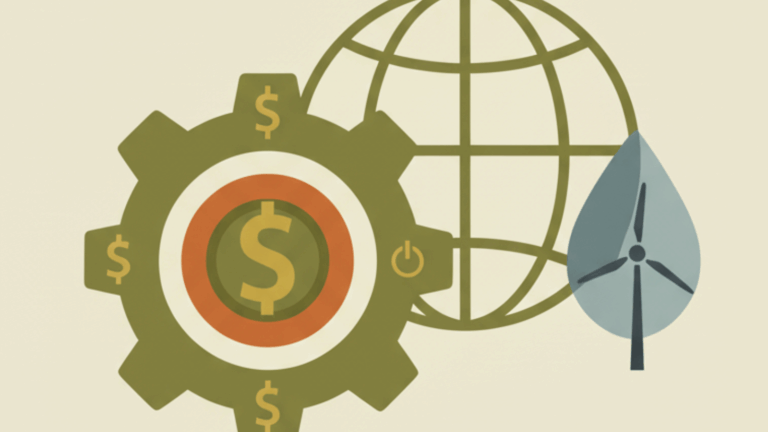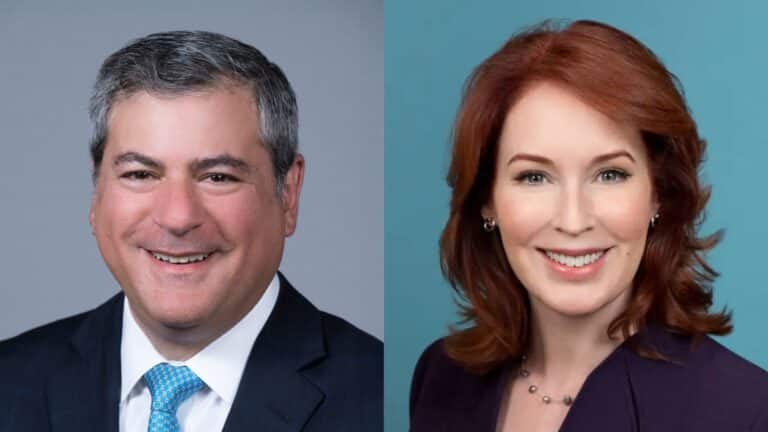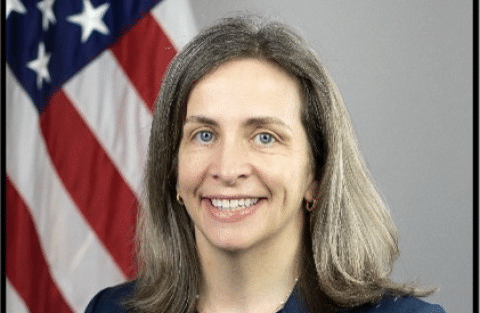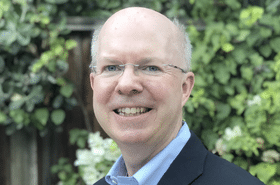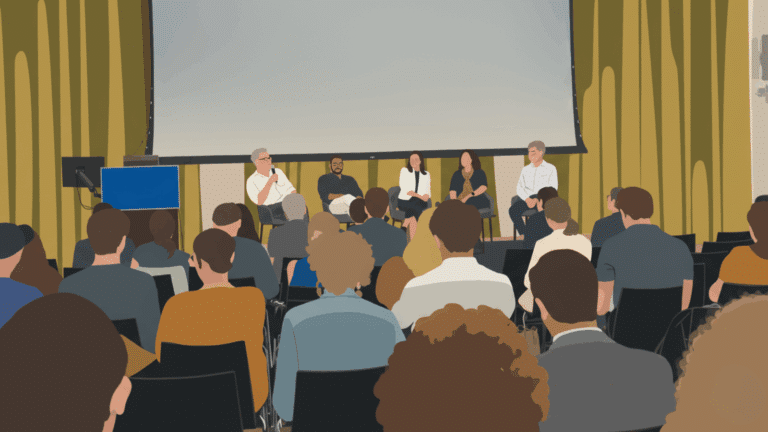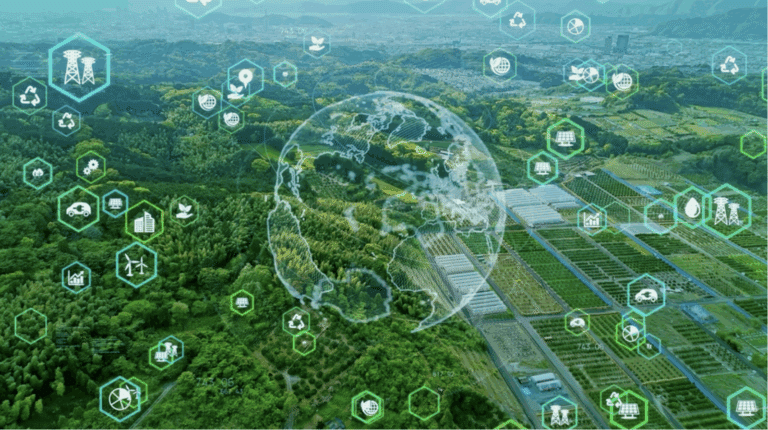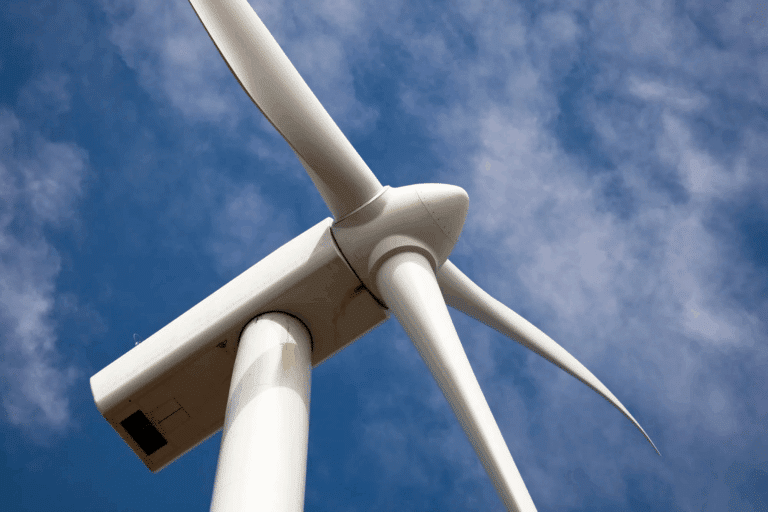David Crane: The goal of achieving a zero-carbon electricity sector by 2035 now, it seems quite challenging, but momentum builds on momentum. And I think the momentum that we’re starting right now is going to be hugely important.
Bill Loveless: Thanks to the Bipartisan Infrastructure Law and the Inflation Reduction Act, the Department of Energy has been flush with cash for the past couple of years. We’re talking nearly $100 billion between the two measures to put toward clean energy and grid development projects around the country, through funding and loans. There’s an expectation that these contributions will drive private investment as well. And they are. This July, the DOE reported awards of nearly $50 billion already.
So, where are these funds going and what effects are they having on clean energy applications around the country? How is the DOE addressing nationwide energy challenges like transmission line permitting, storage, and other hurdles to decarbonization? And how stable are these programs if Republicans retake power in the November elections? This is Columbia Energy Exchange, a weekly podcast from the Center on Global Energy Policy at Columbia University. I’m Bill Loveless. Today on the show, David Crane. David is the undersecretary for Infrastructure at the Department of Energy. He previously served as director of DOE’s Office of Clean Energy Demonstrations. He was also CEO of Climate Real Impact Solutions, as well as NRG Energy. I hope you enjoy our conversation. Undersecretary David Crane, welcome to Columbia Energy Exchange.
David Crane: Bill, thanks for having me.
Bill Loveless: And appreciate you taking the time. I know there’s a lot of work there at Forrestal. And I have to say, I remember many fond days as a reporter walking the halls of Forrestal, popping my head into doors and asking, “What’s going on?” And something that is no longer possible these days with security at all.
David Crane: Yeah. I was going to say that is not an experience I’ve had at Forrestal is members of the press just popping their head into the office.
Bill Loveless: Yeah. Those were the good days. But here you are after a long career in the private sector, one with many accomplishments, and you’ve joined the federal government in the twilight of your career. Why did you do so Mr. Secretary, and what are some of the things you learned from that experience that show up in the work that you do there today?
David Crane: Well, Bill, as you mentioned, I am a private sector person. Sometimes when we really get into government tease within the Department of Energy, I like to remind people that I’m a private sector person masquerading as a government official. But you’re right, I was at the end of my career in the private sector, transitioning from being a longtime CEO of an energy company into doing board work, which is the normal path. And I got a call from actually the chief of staff of the secretary of energy, Secretary Granholm, saying that they had reorganized the Department of Energy in response to the Bipartisan Infrastructure Law.
And because the department was being given this historic amount of money to stimulate, to catalyze the clean energy transition, that they were creating a vertical of brand new undersecretary for infrastructure. And they were looking, because the heart of the Bipartisan Infrastructure Law is a bunch of projects in emerging clean energy technologies where the private sector would lead, but the government would enable. They wanted a private sector person to lead it. And when it was presented to me, $100 billion, the opportunity to oversee the deployment of close to $100 billion against what to me is the existential threat against humanity, it was not a hard decision for me to make to do public service.
Bill Loveless: Yeah. And I want to get into all of those activities that you oversee as the undersecretary. But again, just looking back a bit on your career, I’ve read where you said the oil crises of the 1970s left an impact on your perspectives on energy policy. I know you were a young man back in the 1970s, but nevertheless, what impact did that leave on you in terms of how you view public policy?
David Crane: Well, as you said, since you’re talking about the 1970s, which of course now is 50 years ago, I want to make sure that I position myself as a very young man at the time. But in the second oil shock, the 1979 one, I was a young man who was just driving for the first time. And, Bill, you remember what it was like for young drivers in terms of going to their first job with the lines at the pump and things like that. And just really affected the lives of everyday Americans. And as a person who went on to college and studied international relations, and being proud American, and being proud of the world that the United States has created, I could never understand how we allowed ourselves to be compromised by dependence on foreign sources of oil for 40 to 50 years. And no one in Washington from either party ever seemed to be able to do anything about it.
And so, you have that national energy security concern, and then the climate crisis on top of that. And new technologies come along basically using America’s bountiful natural resources, our solar power or our wind resources, and you can solve both problems at one time. And so, I ended up getting into the industry and basically having the opportunity to even look beyond just being a private sector person and doing it on a national and global level. It’s just the opportunity of a lifetime.
Bill Loveless: Yeah. And again, what do you look back on in your career, say as CEO of NRG and other roles that you have played, the things you learned there that you think are particularly applicable now in your role at the Department of Energy?
David Crane: Well, the life lessons that I learned over 40 years in the private sector, there’s so many of them that have been directly applicable to this role that it’s hard to pick. But I would just mention two things, one really macro and one a little bit more process oriented. One on the macro level, I went to law school, original career goal was to be a person that put bad guys behind bars. And then for a variety of reasons I won’t bore you with, I ended up as a corporate attorney. And then I backed into being in the energy sector and in the electricity portion of the electricity sector. And I used to joke to my law school friends, if you had told me when I was graduating from law school that I would sell electricity for my whole life, a product that you can’t see, you can’t smell, and if you touch it you die.
But the importance of electricity, and I think what animates the electricity industry, and I’m very proud of this, is that electricity makes all modern life possible. It makes healthcare possible, it makes everything possible. And there’s challenges to electricity. It’s a commodity that has to be produced in real time. Only now are we getting to the point of large scale storage. So, the connection with what I did in terms of the industry in the private sector and the public sector is exactly the same. Energy underpins everything. And you find the most committed people in this sector and it’s just a privilege to work around them.
Well, and just one other thing I would say that is something that seems small but has been very important, I think is my direct impact at the Department of Energy is we are doing all this capital deployment through competitive processes because it’s got to be done fairly, level playing field, taxpayer money. And historically, the Department of Energy, when they gave out awards, historically much smaller awards, in the selection process they never would actually meet the people.
Bill Loveless: Really?
David Crane: And one of the changes that I instituted to the selection process, which has caught on and I think has been extremely important, is I just came in, I said, look, if we’re giving $100 million to someone, much less some awards we have have been over $1 billion, I’m not doing that without meeting the people first. We’re going to have a in-person interview process as part of our selections. And there was some resistance at the beginning, but it’s completely taken hold. And I think one of the reasons that you have not seen a lot of stories about the Department of Energy making bad selections is because our process for picking winners I think is so much improved over the past.
Bill Loveless: Interesting. There’s you, a veteran of the private sector at DOE, but what about the rest of the official ranks in the workforce at DOE? Is there a different look to it now, one that reflects the commitment to this new commercialization aspect of the Department of Energy?
David Crane: Well, my vertical, my infrastructure vertical has over 1,000 folks in it. And I would say, I don’t actually have data, this is 1,000 people in offices, most of which did not exist two years ago. And I would say that it breaks into three parts. 1/3 from the private sector, 1/3 who’ve come over from other parts of the Department of Energy. And 1/3 who’ve come from other parts of the government. And weaving those three together has been a challenge for myself and for other leaders of the program offices. But overall, as we sit here two years into the process, I’m extremely pleased that we have a situation if you take those three groups where one plus one plus one is equaling 10. If done wrong it could be one plus one plus one equals minus three. And I think the reasons that we’ve been able to harness private sector experience with DOE knowledge and other government folks who’ve self selected to come over is that everyone’s rowing in the same direction.
Everyone realizes that the Bipartisan Infrastructure Law, as enhanced by the Inflation Reduction Act, is probably humanity’s last great chance to bend the curve on climate change. And so, people have come together and worked together in a positive way rather than say, not invented here syndrome or things like that. So, I would say my biggest concern coming in, because we used to do this at NRG, we’d say, oh, maybe we’re too far in the woods, let’s get someone from the completely different life experience that can give us a fresh perspective. Companies do that all the time, and 9 times out of 10 the organism rejects the foreign body. I was afraid when I came in the long-time government people would reject me as a foreign body. And the willingness of the government folks to recognize that with this private sector led that we’re going to have to do things a little bit differently. From me and others has been the most positive aspect of the whole experience.
Bill Loveless: Yeah. Well, from your private sector experience, but particularly at NRG, you’ve had experience in really pushing the needle forward rather aggressively. At NRG you really moved that company in a big way into renewable energy. And ultimately things didn’t work out, you were ousted as the CEO and the company now, as I recall, is virtually reliant on no renewable energy going forward. But still, you pushed the envelope there and you find yourself pushing the envelope a bit again here at DOE.
David Crane: Yes. But certainly at the Department of Energy… I think what I confronted at NRG was some folks, particularly at the board level, who were uncomfortable with the pace. I think basically the difference, what I was espousing then, and as you said, I left, I got fired from NRG at the end of 2015, what I was articulating is the future that we need to be aiming for at NRG is the future that has come, the transition. Even in 2015 you had people saying that solar energy was not a serious technology. It would never be more than a fringe, 1% of the overall mix. And you see what solar and wind are doing now as the largest sources of new capacity in the United States. So, the old cliche in business that timing is everything, I’m not saying that the NRG folks were wrong to oust me, I’m saying that maybe my timing was wrong. I was there premature.
With government, timing is still important, but it’s not really as much market timing, it’s just urgency. Everything we have to do is urgent now, and move forward at a pace which the government, the DOE, we work on nuclear weapons at the DOE, the creative destruction that the private sector is used to, the DOE, the mindset is, no, we can’t get anything wrong when it comes to nuclear materials. So, in our end, there’s a different mentality, but some of the dynamics you’re dealing with are different than when you’re in the private sector for sure.
Bill Loveless: Well, your role at DOE, as we say, the undersecretary for infrastructure is a new one, or relatively new, goes back a couple of years now, and responsible for overseeing DOE’s obligations under the Bipartisan Infrastructure Law and the Inflation Reduction Act. Those laws fundamentally changed the mission of the department. They provided DOE with nearly $100 billion, and as of July I read DOE supports awards of nearly $50 billion. So, there’s a lot of details behind that number, but generally speaking, how is that money being spent, and to what extent is it being matched by private capital?
David Crane: So, the second question has the much easier answer. The statute requires at least 50% non-federal cost share. And because we were… Most of our programs are specific technology driven, and I’ll get into that in a little bit, but because we ran very highly subscribed competitive processes where we made it clear that while the statute said 50% non-federal, we told people just ask for what you need from the government, because if someone asks for 50% government money as opposed to 25%, and the projects are otherwise equally meritorious, we’re going to go for the 25%. One of our jobs is to stretch the federal dollar as far as possible. So, right now, one of the great stories which is now of the say 50 billion of government money selected, the rate of private sector subscription to that is running two, two and a half to one. So, 50 billion of government money is begetting 100 to 150 billion of private sector commitment.
Bill Loveless: Yeah. Well beyond what the laws require, right?
David Crane: Yes, exactly.
Bill Loveless: Has that been surprising?
David Crane: No. It’s a pleasant surprise, yes. Just take the Hydrogen Hub Program, which was $7 billion, and the statute said that they wanted us to do four hydrogen hubs without money. We selected seven because we could get more bang for the buck because of the greater private sector contribution. So, we have examples like that across all the programs. And so, we have 56 programs total, to the other part of your question. Most of them are technology driven. And so, we have a huge number of transmission programs in the Office of Clean Energy Demonstration. We have hydrogen, we have industrial decarbonization, we have advanced nuclear, we have long-duration energy storage.
Then we have a manufacturing supply chain office that’s making sure that we don’t trade dependence on Middle Eastern oil for dependence on foreign country manufacturing critical supply chain. So, they have battery awards and the like. So, we have a lot of different programs and they cover almost every clean energy technology that you could think of. I would say what I see as the two examples that didn’t have specific technology driven programs would be, on our side, on the commercial deployment side, would be there was not a program for advanced geothermal and there was not one for offshore wind. But there is DOE money on the R&D side for those two technologies.
Bill Loveless: Right. I looked over the so-called Liftoff Reports that the DOE has issued over the past couple of years, which illustrate the potential for clean energy technologies as well as the obstacles. I’d like to touch on two or three of those reports. Including one on the electric grid, a field where you have plenty of experience as we’ve discussed. In this report, the department notes that many advanced grid solutions are commercially available today to help grid operators and regulators address capacity, and issues, and reliability priorities, and modernize the grid. And that could be done without increasing costs for ratepayers according to the department. That sounds encouraging, but there’s not as much being done as the report suggests is needed, right?
David Crane: That’s correct.
Bill Loveless: And how does DOE help there?
David Crane: Well, Bill, the way we think, we’re doing a lot in transmission and it breaks down into three groups. One is on the permitting regulatory right-of-way side. NIETC federal transmission quarters, we’ve started a thing called CITAP, which is a federal government permitting shot clock where the eight federal agencies involved in permitting interstate transmission lines now have to work through the DOE and telescope what’s usually close to a decade long process into two years. So, we have that. We have programs that help with transmission lines, new transmission lines, but what you’re talking about in the Liftoff Report, grid modernization, that basically means getting more capacity out of our existing lines. Everything we can do without building a new line across a new right-of-way. And it’s about 20 some different technologies. And one of the things that people struggle with is solutions in the transmission world tend to be very situationally dependent.
So, it’s not just a solar panel, put it anywhere. But the Liftoff Report, and it sounds like you’ve read it more recently than I have, is that I think the Liftoff Report says something like we could, without building a new transmission line in the United States, we could get something like 90 gigawatts of new throughput just by comprehensive grid modernization. So, it hasn’t happened even though each individual technology exists. And so, the way that we are stimulating that is through the grid modernization awards, of which we’ve already put out a couple announcements, there’s another one coming out soon and then there’ll be another solicitation, is a show and tell. Funding 30 or 40 different projects of different configurations across the country, large utilities, medium utilities, munis and co-ops. And we’re hoping that if other utilities, other transmission and distribution companies see what’s being achieved next door, then that will lead to a ripple effect of people doing it and people persuading their public service commission that this is money well spent.
Bill Loveless: Yeah. I’ve heard Jigar Shah, the head of the loan office, which you also oversee there at DOE, say that these are options that appear to be often overlooked as opportunities, and ones that can make a big difference, even short of building the long-distance transmission lines, which of course are still necessary. But you feel as though the department, through these various initiatives, could help build the momentum to see those technology improvements on existing lines implemented relatively soon.
David Crane: Yeah. And the Liftoff Report, and this would hopefully go on over the next few years, the Liftoff Report is our first salvo into not just leadership with our money, but intellectual know-how leadership beyond pure technology. The Liftoff Reports will be living breathing documents and hopefully will become guideposts for people that want to get the lay of the land as they think about what they want to do in this sector.
Bill Loveless: Of course long-term, long-distance transmission lines are really the solution in many cases to move clean power to regions where it’s most needed, permitting there is still an obstacle and there’s efforts continuing in Congress to try to fix that. But that’s been the case for a long time now. Are you at all optimistic that there could be some bigger solution coming from Congress anytime?
David Crane: So, the thing I mentioned before, the CITAP, is certainly a start, but you’re saying we at the department, Bill, they didn’t bring me in the department to be a policy person, they brought me in to strap the crash helmet on and implement things. But certainly my boss, Secretary Granholm, has made it clear that we would love to see comprehensive transmission reform. If you think of the building blocks, we’re so happy to have, Bill, IRA, and then there was the CHIPS and Science Act that’s also related to this. But the fourth leg of the stool as we thought, never let perfection be the enemy of the good or whatever this is. But we would’ve loved to see comprehensive permitting reform because at this point I think the obstacles that people talk about in the permitting, which probably were put in place to safeguard the country, the people, against polluting elements, at this point I think it’s more inhibiting clean energy projects than… Delaying or just making it more difficult than it needs to be. So, yeah, we’d love to see comprehensive permitting reform.
Bill Loveless: Among the other fields written about in these Liftoff Reports is nuclear energy, which the department observes is at a commercial stalemate between potential customers and the investments that are necessary in the nuclear industrial base. That puts decarbonization goals at a big risk, right? What will it take to overcome that stalemate to prompt this revival in the nuclear industry? I know there’s a lot of research and even commercial efforts going in to try to bring about small modular and advanced reactors, but it still seems as though there’s a ways to go.
David Crane: Yeah. I think the nuclear Liftoff Report came out in the spring of ’23, and I would say on the stalemate question, while it’s not broken yet, I think there’s a clear line of sight. If you just think of the phenomena of AI-driven data centers. And if you think of the extraordinary amount of electricity demand, which has to be base load and for a variety of reasons needs to be zero carbon as well. And then if you look at the strength of the companies that are going to be behind those data centers, I think the path clear to breaking that stalemate is their deep involvement in the process on top of the exciting technologies in the ARDP program, the Advanced Reactor Demonstration Program, that we’re running.
The modular reactors, I don’t know if this is serendipity or what, but the size of the modular reactors and the commercial purpose of them is so ideally fitted for the data center phenomena that those two are going hand in hand. So, we’re now getting down to next level issues. Which nuclear is a fiendishly difficult technology, the stakes are extraordinarily high. The Gen 4 reactors are almost a complete redo of the Gen 3. So, there’s a lot that still needs to be worked out. But I would say the biggest evolution in my own personal thinking over the two years that I’ve been at the Department of Energy is that in the moments of hyperbole I’ve said new nuclear is the one technology we have, which just has to happen at this point. And so, I’m very bullish on where we’re going, although there’s a lot of work left to be done.
Bill Loveless: Right, right. Of course we’ve seen the Vogtle nuclear power plant in Georgia. There’s two Westinghouse AP1000 pressurized water reactors that have been built and gone online. But these were what, seven years later than initially proposed and at a cost of some $35 billion. And that was more than double what was initially planned. So, the cost of this technology is still extraordinary and daunting for people who hold positions like you once did as a CEO of an electric power company.
David Crane: Yes. Well, first of all, congratulations to Georgia Power and with LPO’s help getting Vogtle across the line.
Bill Loveless: The loan program office.
David Crane: Yes. But as you say, it was significantly more expensive and took many more years. And that’s obviously what we’re trying to avoid when we talk about Gen 4. And as at NRG, we tried to build a new nuclear plant at the South Texas site. And one of the things about the last generation, the Vogtle generation, is that the units are just so large. You have to get so much skilled labor, and I’m talking hyper skilled labor like certified nuclear welders on one site, usually in a very rural place. That I think one of the virtues of the modular reactors is that more of the work is going to be done in factories where it’s easier to get the benefits of scale.
So, obviously we’re all working to make sure that… One of the important things about first of a kind as a reference plant is to be a proper reference to get people to want to follow. You have to get it done at least close to on time and on budget. So, we’re taking the project management of the ARDP program very, very seriously because it’s the key to unlocking successful follow-on projects. We don’t want first of a kind to become last of a kind.
Bill Loveless: Do you see a modular reactor up and running in the United States, I don’t know, 10, 15, 20 years?
David Crane: 10, 15, 20 years, yes I definitely see that. I was afraid you were going to say three, four, or five years and make the question difficult for me. But certainly… And I think one of the… But your question of how long it will take, and I’m very comfortable with that timeframe, 10 to 20 years, and I’m very comfortable that the demand, like I said before, from data centers and the like, is going to be enormous for those projects. But one of the challenges that we need to confront is what’s the bridge technology?
Because the data center folks, and of course Silicon Valley people speak with a hyperbole, an enthusiasm for what they do, which is different from people in the energy sector who tend to be dour and conservative. But no one who’s building data centers is going to say, we can wait until 2035. Right? They’re like, we’re going to be having these data centers up well before the end of this decade. So, one of the challenges we all have to face, because we want the United States to lead in that data center revolution, is even if nuclear is the ultimate solution, what’s the bridge solution that allows those units to get up and running when they need to be running while nuclear is still on the way?
Bill Loveless: Yeah. Is there an opportunity there for those technology leaders, the ones with the data centers and all, to weigh in and help make possible the implementation, the commercialization of new nuclear, small modular nuclear?
David Crane: Oh, certainly. And I don’t want to speak for them, but I think there’s recognition that they need to be more actively involved in… And one of the things that has hampered nuclear in the United States relative to other countries like in France, is that while American power companies are big, because power companies in U.S. have historically been organized on a state by state level, they’re not as big as utilities, power companies in other parts of the world. And nuclear requires big companies to do it.
Now, when you talk about the companies that are building data centers, you’re talking about the biggest market cap companies in the world. And so, they can get involved. Historically it’s not been their business to be power generators. So, you would have to ask them what their involvement is, whether they just want to… Plenty of them have been signing offtake agreements for zero carbon power from solar and wind. And so, I think one of the things that’s going to become clearer over the next year, and I don’t think that each of them will have the exact same strategy, but I think you will see them articulating how they’re planning on dealing with this issue. Because it’s fundamental, obviously, to getting the data centers done. It’s not just a nice to have, it’s a must have.
Bill Loveless: Right. Another topic that’s near and dear to your heart is carbon management. Again, there’s a Liftoff Report on that, as there are on all of these fields at DOE. And that report suggests that U.S. energy transition goals will require capturing and storing, I think the number was like 400 to 1,800 million tons of carbon dioxide annually by 2050 through point source carbon capture use and storage and carbon dioxide removal. Today that DOE report knows the U.S. has over 20 million tons per year of carbon capture capacity. And that’s some maybe 5% of what would be needed by 2050. Are we likely to see a sufficient investment in these technologies going forward? Because it seems like there’s a tall order there. There is a tall order there.
David Crane: Well, there’s really two parts to the question. There’s point source, and you only mentioned point source, but of course there’s direct air capture as well. And we’re very proud of the two projects we’ve announced in DAC, and we appreciate the step-ups in technology and also the commitment. One of the two projects, the ultimate owner of the project is Occidental Petroleum, in a direct air capture project. And so, the involvement of large incumbents who have the skill sets and the infrastructure is very welcome from our perspective.
The statute, particularly when it came to direct air capture, we like to say internally required the greatest technology leap. I think at the time the statute was passed, the largest direct air capture project in the world was 4,000 tons a year. And the statute said, “We want you to give money to projects that can do a million tons a year.” So, you’re talking about a 250 times scale up. So, we awarded two of those projects. They’re going forward. On the point source we have a lot more projects, not only across the carbon management, but in the industrial decarbonization program. Carbon management, carbon capture, usually those projects involve a range of technologies, electrification, carbon management, use of hydrogen as an input fuel.
So, we expect a lot of progress. One of my, I’m a simple guy, I didn’t have the benefit of a business school education, but I believe that capitalism has to be properly directed. And capitalism solves for something that they’re going to get paid for. So, when you’re talking about technologies whose only purpose in life is to take carbon out of the atmosphere and there’s no price on carbon, then you have to go through some gymnastics to say, well, what’s the economic rationale for doing it? When you talk about Liftoff, the way we’re thinking about that now is that if through this next range of projects we’re doing we can get the cost of carbon capture, point source and DAC, down by a multiple factor, then that enables… And there’s tax credits there that are very helpful to the sponsor. That if we can get it closer to being a cost that is manageable, then that offers either other private sector solutions or other government public policy solutions.
Bill Loveless: Right. The cost recovery in the past has been enhanced oil recovery, right? You had some experience with that at the Petra Nova project in Texas, a project that NRG and Nippon Oil and Gas built the project at a coal-fired plant in Texas. And that CO2 was piped to an aging oil field elsewhere in the state. That project stumbled a bit, it’s back online as I understand.
David Crane: Is it?
Bill Loveless: Oh.
David Crane: I don’t know. I don’t know.
Bill Loveless: But there was a recovery, and I guess when the price of oil went down that’s when that project stumbled a bit. Some say these investments are simply marketing or greenwashing policies for oil and gas industry to extend the useful life of their reserves. What do you make of that?
David Crane: Well, enhanced oil recovery as a way to scale up the capture technology back at the time, again, with no price on carbon, that was the best option. The whole question of capturing carbon in order to use the CO2 as a resource that you can embed in something else, Bill, I’m sure you’ve seen this thing that when they make cement, which is a huge volume product, and the problem is we have so much CO2 you really have to talk about huge volume products that you could embed. I think they say 10% of CO2 in cement, and that could be a billion tons there in theory. That whole area, which I call materialization, some people call utilization, we’re seeing interesting things, embedding the CO2 in various synfuels and all. I think there’s a long way to go there, and the statutes recognize that. And so, there’s incentives for sequestration as well.
But these are just all important areas that need to be advanced. Because even if you’re of the view that we just have to just stop using fossil fuels full stop, and that’s not my personal view, that we could have a world that’s just solar and wind and batteries. But there’s just so much existing infrastructure that’s dependent on fossil fuels. Getting the whole carbon capture program down to the point where we can keep using those facilities but keep the carbon out of the atmosphere, it’s a fundamental building block. And we’re excited about the projects that we have in our portfolio that are going to do that.
Bill Loveless: Thinking again about the grid, the president has set as a goal a carbon-free utility or power grid by 2035, it’s quite a challenge. What do we make of that and how likely is the U.S. to come say even close to that?
David Crane: Well, the one thing that… I’ve been around the power sector since the Clean Air Act Amendments of 1990, and that idea of giving the power sector a long runway and then let capitalism get after it, it worked fabulously well when it came to SOx and NOx. I think the runway they gave with the SOx and NOx programs was to serve close to eliminate SOx and NOx over 15 to 20 years. And by the time I got very deeply involved in it, which was about 12 years in, the industry was way ahead of schedule.
And no one was predicting that in 1990. They’re like, oh, there’s no way we’re going to be able to do this. And so, the goal of achieving a zero carbon electricity sector by 2035 now, it seems quite challenging, but momentum builds on momentum. And I think the momentum that we’re starting right now is going to be hugely important. And, Bill, I just want to be alive in 2035. I don’t want to handicap or make a personal bet over a beer with you as to whether we’ll get fully to zero, but I’m highly confident if we’re not at zero we’ll be very, very close to it.
Bill Loveless: Look, maybe more of a nearer term goal. DOE has gone quite a way in obligating and distributing funding and loans that it’s responsible for under these two big laws. Do you think you’ll have obligated all of that $100 billion by the end of the year?
David Crane: So, Bill, in the world of government accounting, I don’t want to scare you with how much time we’ve spent internally figuring out what the actual denominator is. So, just a slight complication, the number that we’ve determined as to what we can achieve before the end of the administration is roughly 80 billion because those bills, some of the money that was allocated to us were for future government fiscal years. And so, our target for now for what we can do in this four year segment is 80 billion. And then one other complexity, in our lingo, there’s selected and then there’s awarded slash contracted.
So, selected means we’ve run a competitive process, we’ve identified and announced who’s won it, and then there’s a contracting process. So, by the end of the calendar year, which we use as a proxy for January 20th, we expect to have something like 97% of the 80 billion available selected, and something like 2/3 of that number awarded slash contracted. I’m very proud of those numbers. I have to tell you, when I joined two years ago and they showed me the spreadsheet of what we had to achieve, it’s the first time in my life I looked at a document and I started to hyperventilate. We were barely staffing up at the time. I had to set it down for a moment before I picked it up and said, “Okay, we got to get after this.”
Bill Loveless: What happens if there’s a Republican White House and a Republican Congress as of next year? What happens to these programs? Do they have enough traction to survive?
David Crane: Well, we’re dealing with a half Republican Congress right now, just the first part of your question. And what I would tell you, because one of the best parts of my job is to go around and announce these selections. And by the way, I had a great experience just a month ago where actually our first finished project which-
Bill Loveless: What was that?
David Crane: It was a battery recycling plant where… Bill, you would’ve loved this. It was a company that was doing battery recycling in Ohio, southern Ohio, and it had been recycling little Energizer batteries for the last 30 years. And as you can imagine, that equipment is not well suited for giant batteries coming out of electric cars. And so, we funded with them a new production line. And it was great. And the enthusiasm in Ohio of the workers, the management, the mayors, tremendously exciting. So, we’re actually starting in the world of ribbon cuttings as well as announcements and groundbreakings.
But what I would say on the partisan divide is that when I go around, and for some reason compared to the secretary and the deputy I tend to draw Republican states. I’ve spent a lot of time in Indiana making announcements. And I had an experience with the governor of Indiana where we were announcing something, a cement plant, Heidelberg, $500 million investment to decarbonize the second-largest cement plant in the United States, in Mitchell, Indiana, I believe it was. And the governor was there. I didn’t know him very well. He’s a very tall guy. We have a picture of everyone, the obligatory picture in front of this giant earth mover, and there’s a giant Biden-Harris sign there. And I said to the governor, who had made very gracious remarks, I said, “Governor, you don’t have to stand in front of that sign. We can take the picture elsewhere.” And he said, “Look, I’ll stand in front of any sign if it means more jobs for Indiana.”
And so, the support for these programs, certainly at the state, like the gubernatorial level, and I would say in the House and Senate where support for infrastructure and local jobs is paramount, we have not run into… We just have a lot of bipartisan support. I can’t really say, obviously, what the Trump administration would do. More of the IRA has been focused on the tax credits than the… But once we have all these projects awarded, contracted, there’s no history of the United States government reneging on contractual obligations. And even projects that are selected but not contracted, a lot of them are in Republican states. And I imagine if someone moved to cancel them there would be a lot of Republican senators that would call up and say, you shouldn’t do that. So, I think the programs will continue. Obviously, I think we who gave birth to these projects are the better stewards of them. Elections have consequences, but I don’t think they’re going to… Momentum may slow a little bit, but the trajectory, the direction is not going to change.
Bill Loveless: Yeah. Well, there’s so much going on there, so much has occurred over the past few years and continues to happen there at the Department of Energy. David Crane, thanks for coming on Columbia Energy Exchange to discuss this with us today. We appreciate it.
David Crane: Bill, thanks for having me.
Bill Loveless: That’s it for this week’s episode of Columbia Energy Exchange. Thank you again, David Crane, and thank you for listening. The show was brought to you by the Center on Global Energy Policy at Columbia University School of International and Public Affairs. The show is hosted by Jason Bordoff and me, Bill Loveless. The show is produced by Tim Peterson from Latitude Studios. Additional support from Noah Kaufman, Lilly Lee, Caroline Pitman, and Kyu Lee. Roy Campanella is the sound engineer.
For more information about the show or the Center on Global Energy Policy, visit us online at energypolicy.columbia.edu, or follow us on social media @ColumbiaUEnergy. And if you really liked this episode, give us a rating on Spotify or Apple Podcasts. You can also share it with a friend or colleague to help us reach more listeners like yourself. Either way, we appreciate your support. Thanks again for listening. See you next week.
